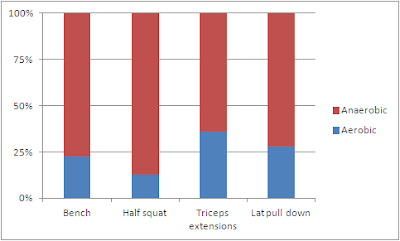 |
| Image 1: The squat - as intense as it is, it is no replacement for "aerobics"; more on squatting in the EMG Series |
As a diligent student of the SuppVersity you will obviously remember
yesterday's news on the potentially detrimental chronic increases in cortisol, Kirschbaum et al. (
Kirschbaum. 2011) have observed in a group of 304 amateur endurance athletes.
This raises the question, whether or not your 3-4 strength training sessions per week would not suffice as "aerobic exercise" - after all, most people are huffing and puffing much more after one sets of squats than after 45 min. on a recumbent bike. And even if you were not interested in increasing your aerobic performance, I assume it would be nice to know if squats really are so energetically intense as they feel, or, in other words, how much more energy you are expending doing squats vs. let's say triceps extension ;-)
And more generally, i.e. in view of the aerobic effect and energy expenditure in the course of a complete strength training session, it would be interesting to know, ...
- how much total energy you were expending while benching, squatting, rowing and co., and
- what the relation of aerobic to anaerobic energy expenditure was like during heavy resistance training.
Both questions have been a subject of scientific debates for quite some time. The measurement of blood lactate levels, as well as other methods to access total energy expenditure, the ratio of aerobic to anaerobic metabolism and the highly controversial contribution of increased energy expenditure
after resistance training (EPOC) have been questioned lately (
Robergs. 2007). Reason enough for Jefferson M. Vianna and his colleagues from Brazil and Portugal to take another,
closer look at the total and relative energy costs of resistance training (
Vianna. 2011), in order veri-/falsify previous empirical data.
As their measuring tool of choice, the scientists selected
the
oxygen deficit method (AOD), where the anaerobic contribution to the overall energy expenditure is estimated by linear extrapolation of the VO2 at supra-maximal intensities and the AOD is then calculated by subtracting the cumulative oxygen uptake (VO2Ac) from the estimated energy demand. As the scientists point out, thus...
[...] the VO2Ac represents the portion of energy obtained by aerobic processes and the AOD represents the portion of energy obtained by anaerobic processes [so that] their sum equals the total VO2 during exercise.
The subjects in the Vianna study were
14 male resistance trainees (26.6 ± 5.4 years, 1.77 ± 0.07 m height, 80.1 ± 11.4 kg body mass and 11.2 ± 4.6 % body fat) with at least one year of training experience on a protocol with three or more training sessions per week. After height, weight and several skin fold measures (chest, mid-axillary, tricipital, sub scapular, abdominal, supra iliac, and thigh) had been taken, the individual 1RM max for
bench press, half squat, lat pull down and triceps extension were assessed. Afterwards, the scientists measured the VO2 for each of the four exercises at 12% and 20% of the previously established 1RMmax. The same procedure was repeated 48+h later at 16% and 21% of the individual 1RM max. Eventually (again 48+h rest), the
subjects had to perform their bench presses, half-squats, lat pull downs and triceps extension at 80% of their 1RM. The gas the subjects expired during those sessions was collected and recorded by an open air circuit analyzer - you can see part of the results plotted in figure 1.
 |
| Figure 1: VO2Ac (ml/kg) and accumulated oxygen deficit (AOD; ml/kg) at 80% 1-RM for bench press, half squat, triceps extension and lat pull down (data adopted from Vianna. 2011). |
If you recall what the scientists said about the interpretation of VO2Ac and the accumulated oxgyen deficit (AOD), it is pretty evident that
there is a reason, why many trainees fear the the squat. After all, the "king of all exercises", as it is commonly referred to, has by far the highest total (cf. figure 1), as well as relative (cf. figure 2) anaerobic component of all four tested exercises.
 |
| Figure 2: Relative contribution of aerobic and anaerobic metabolism to overall energy costs of bench press, half squat, triceps extension and lat pull down at 80% of the individual 1RM (data adopted from Vianna. 2011). |
Despite inter-individual variations this
supremacy of the squat is statistically significant (p<0.05, indicating chances that this was an incidental observation are <5%).
 |
| Figure 3: Total energy demand (ml/kg) of bench press, half squat, triceps extension and lat pull down at 80% of the individual 1RM (data adopted from Vianna. 2011). |
If we finally take a look at the total energy demands, the underlying reason for your panting becomes even more evident:
Squatting is 3.3x more energetically demanding than bench pressing or doing triceps extensions or lat pulldowns.
The "king of all exercises" is in fact so energetically demanding that one set of squats at 80% of your 1RM max will still expend ~9% more energy than a workout consisting of bench presses, triceps extensions and lat pull downs! Nevertheless, while it cannot be excluded that squatting will
indirectly improve your aerobic exercise performance, as well,
in and out of itself, none of the tested exercises is suitable to replace what is commonly understood to be "aerobic" or "cardio training" - but hey, in view of what I have posted about the
effects of HIIT training, lately, doing (regular) "cardio" training may be obsolete, anyways ;-)



